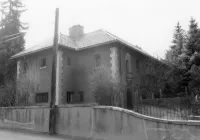Share what you know,
and discover more.
Share what you know,
and discover more.
Jul 27, 2005

-

- Charmaine Bantugan
National Register of Historic Places -Kohn House
Statement of Significant: The Kohn House is significant in categories identified in the Multiple Property Documentation Form "The Architecture of Jules Jacques Benois Benedict in Colorado." The Kohn House represents the "Domestic Building" property type and is associated with the historic context "The Architecture of Jules Jacques Benois Benedict in Colorado, 1909-1942." The period of significance for the property extends from the residence's completion in 1925 through 1943, the year that original owner Samuel E. Kohn died. The Kohn House is significant under Criterion C, in the field of architecture, as a work of master architect Jules Jacques Benois Benedict. The house was built in 1925, in the middle of the decade of Benedict's most prolific output. The two-story dwelling with rounded corner entrance at the intersection of two wings is the only known example of a triple-axis residence plan in Benedict's work. The combination of quality materials elegantly employed and the artistic use of ornamentation created by skilled craftsmen throughout the house were hallmarks of the architect's work. The house is also significant under Criterion C as an example of the Italian Renaissance style, one of the Beaux-Arts styles employed by Benedict for landmark residences in the metropolitan settings in which he specialized. The style is reflected in features such as the stucco clad brick walls and stone wainscot; the use of light-colored limestone and cast concrete in ornamental features; the low-pitched hipped roof with tile roofing; the broad eave overhang with modillions; the arched doors, first-story windows, and loggia; the classical detailing at the entrance; and the wrought metal grilles and low railings. Important interior features, including in-laid terrazzo floors, a limestone fireplace, stenciled ceiling beams, a sunroom with fountain, wrought metal and crystal chandeliers, and vaulted ceilings, also articulate the style, whose influence is repeated in the associated garage and landscaping. The house is significant under Criterion B for its association with Samuel E. Kohn, who built the house and lived here with his family until his death in 1943. Kohn was a prominent merchant who founded American Furniture Company and built it from a small business to a leading retail firm. He was also influential in professional, civic, and religious affairs, holding leadership positions with National Jewish Hospital, Temple Emanuel, Green Gables Country Club, the Better Business Bureau, and the National Retail Furniture Association.
National Register of Historic Places -Kohn House
Statement of Significant: The Kohn House is significant in categories identified in the Multiple Property Documentation Form "The Architecture of Jules Jacques Benois Benedict in Colorado." The Kohn House represents the "Domestic Building" property type and is associated with the historic context "The Architecture of Jules Jacques Benois Benedict in Colorado, 1909-1942." The period of significance for the property extends from the residence's completion in 1925 through 1943, the year that original owner Samuel E. Kohn died. The Kohn House is significant under Criterion C, in the field of architecture, as a work of master architect Jules Jacques Benois Benedict. The house was built in 1925, in the middle of the decade of Benedict's most prolific output. The two-story dwelling with rounded corner entrance at the intersection of two wings is the only known example of a triple-axis residence plan in Benedict's work. The combination of quality materials elegantly employed and the artistic use of ornamentation created by skilled craftsmen throughout the house were hallmarks of the architect's work. The house is also significant under Criterion C as an example of the Italian Renaissance style, one of the Beaux-Arts styles employed by Benedict for landmark residences in the metropolitan settings in which he specialized. The style is reflected in features such as the stucco clad brick walls and stone wainscot; the use of light-colored limestone and cast concrete in ornamental features; the low-pitched hipped roof with tile roofing; the broad eave overhang with modillions; the arched doors, first-story windows, and loggia; the classical detailing at the entrance; and the wrought metal grilles and low railings. Important interior features, including in-laid terrazzo floors, a limestone fireplace, stenciled ceiling beams, a sunroom with fountain, wrought metal and crystal chandeliers, and vaulted ceilings, also articulate the style, whose influence is repeated in the associated garage and landscaping. The house is significant under Criterion B for its association with Samuel E. Kohn, who built the house and lived here with his family until his death in 1943. Kohn was a prominent merchant who founded American Furniture Company and built it from a small business to a leading retail firm. He was also influential in professional, civic, and religious affairs, holding leadership positions with National Jewish Hospital, Temple Emanuel, Green Gables Country Club, the Better Business Bureau, and the National Retail Furniture Association.
Jul 27, 2005
National Register of Historic Places -Kohn House
Statement of Significant:The Kohn House is significant in categories identified in the Multiple Property Documentation Form "The Architecture of Jules Jacques Benois Benedict in Colorado." The Kohn House represents the "Domestic Building" property type and is associated with the historic context "The Architecture of Jules Jacques Benois Benedict in Colorado, 1909-1942." The period of significance for the property extends from the residence's completion in 1925 through 1943, the year that original owner Samuel E. Kohn died.
The Kohn House is significant under Criterion C, in the field of architecture, as a work of master architect Jules Jacques Benois Benedict. The house was built in 1925, in the middle of the decade of Benedict's most prolific output. The two-story dwelling with rounded corner entrance at the intersection of two wings is the only known example of a triple-axis residence plan in Benedict's work. The combination of quality materials elegantly employed and the artistic use of ornamentation created by skilled craftsmen throughout the house were hallmarks of the architect's work. The house is also significant under Criterion C as an example of the Italian Renaissance style, one of the Beaux-Arts styles employed by Benedict for landmark residences in the metropolitan settings in which he specialized. The style is reflected in features such as the stucco clad brick walls and stone wainscot; the use of light-colored limestone and cast concrete in ornamental features; the low-pitched hipped roof with tile roofing; the broad eave overhang with modillions; the arched doors, first-story windows, and loggia; the classical detailing at the entrance; and the wrought metal grilles and low railings. Important interior features, including in-laid terrazzo floors, a limestone fireplace, stenciled ceiling beams, a sunroom with fountain, wrought metal and crystal chandeliers, and vaulted ceilings, also articulate the style, whose influence is repeated in the associated garage and landscaping.
The house is significant under Criterion B for its association with Samuel E. Kohn, who built the house and lived here with his family until his death in 1943. Kohn was a prominent merchant who founded American Furniture Company and built it from a small business to a leading retail firm. He was also influential in professional, civic, and religious affairs, holding leadership positions with National Jewish Hospital, Temple Emanuel, Green Gables Country Club, the Better Business Bureau, and the National Retail Furniture Association.
Posted Date
Jul 31, 2023
Historical Record Date
Jul 27, 2005
Source Name
National Register of Historic Places
Source Website
Delete Story
Are you sure you want to delete this story?



















